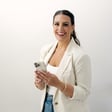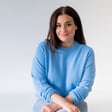Introduction to Brand Guidelines
00:00:00
Speaker
I think that somebody who has strong brand guidelines is really going to have a consistent brand across all platforms. So whether you are looking at their Instagram feed or their website or their digital ads or their email newsletter, everything looks and feels cohesive and it feels like it's coming from the same company.
00:00:20
Speaker
You're listening to the Brands That Book Show, a podcast for creative entrepreneurs who want practical tips and strategies for building engaging brands, crafting high converting websites, and creating reliable lead generation systems for their businesses. I'm your host, Davy Jones, co-founder of two agencies, a brand and website design agency, Davy & Krista, and the digital advertising agency, Till Agency. And I ask questions so you can find answers.
What are Brand Guidelines?
00:00:48
Speaker
What are brand guidelines? Why should businesses have brand guidelines? And how can you create a brand guide for your business? That's what we're covering in today's episode of Brands That Book. This month is all about brand design over at DV & Cresta HQ. And as I mentioned in the episode, I think it's easy for businesses to skip brand design when they're just getting started thinking that things like website design are more important or maybe more practical.
00:01:12
Speaker
But in our opinion, that is a critical mistake. And today's episode focuses on why every business should have a brand guide, which is basically how you practically implement your brand. As always, links and resources can be found in the show notes. Check them out at DavianChrissa.com. And we have a lot of resources that go along with this episode that will help you as you create a brand guide for your business. And if you enjoyed this episode, please consider leaving a review over at Apple Podcasts.
00:01:41
Speaker
Now on to the episode.
Summer Break and Personal Updates
00:01:43
Speaker
All right, we are back with another episode of Brands at Book Podcast and we're coming off a little bit of a break. Yeah, we took a little break this summer because we had kids in and out of school. I had surgery and it's just been a busy summer.
00:01:57
Speaker
Yeah, a little bit of a summary recovery, but I feel like August has been a great break for just kind of reviewing where we're at with our daily routine, looking at the season of life, vision casting for the future. I think it's been a really fun month. Yeah, it has been.
00:02:13
Speaker
Yeah, especially with you feeling better, that's been good too. Yes, it has been good. Yeah, so we won't dig too much into surgery and all that. If you are curious about that, you posted on your Instagram a little bit about that and recovery. I did, yes. Yeah, for sure.
Importance of Brand Design
00:02:26
Speaker
But this month, we're talking about brand design this month. Yeah, I'm excited.
00:02:30
Speaker
Yeah, and as I was looking through our content, it was interesting because I feel like we provide a lot of web tutorials. And don't get me wrong, we have plenty of brand content out there too, but I would say that it skews towards website tutorials, probably in part because it's a little bit more technical.
00:02:49
Speaker
It is and I think that often times, at least after somebody initially starts their business, they're working with someone to create their brand and then I think that if a brand is done well, it's not updated as frequently as a website is. So I created our brand when I was in college and although I've switched out some of the fonts and maybe some of the colors through the years, the actual icon and the brand itself has not changed very much but our website has changed every couple of
Consistency and Trust through Guidelines
00:03:16
Speaker
Yeah, you know, I get the sense though, just in talking to people about people often come to us for website design, you know, and I think that what is on the back burner for a lot of people is brand design because they don't see it as as practical, right? You know, it's like, hey, I'm launching a business, I need a website up and running because it's sort of like my digital business card or however they think about it, right? But they think, oh, I can deal with deal with branding later.
00:03:41
Speaker
so i think there's there's that sense too and i think this month as we focus on brand design we want to talk about or the importance of brand design and having brand guidelines for your business and how that can actually make life i think a lot easier i know for me personally
00:03:56
Speaker
not being a designer among a team of designers. It's really nice for me to have guidelines that I can pull from. Especially, I'm thinking about all the practical things throughout the week, whether it be for social media, what to post, what not to post, things like that. But even as I craft emails, what color should the CTA button be? So those sorts of things I think become a lot easier and just to have consistency across our business.
Components of Brand Guidelines
00:04:23
Speaker
So anyways, in this episode specifically, we're talking about what brand guidelines are, why brand guidelines matter, and then what you can do to craft brand guidelines if you feel like you don't have any yet. All right. So maybe you could walk us through understanding brand guidelines.
00:04:42
Speaker
A brand guideline is a set of rules for how a brand should be implemented. So traditionally, if a designer were doing this for a company, especially like a big corporate company, there might be a very detailed booklet or PDF that walks you through all the different use cases of the logo. So I worked for a corporate company one time.
00:05:07
Speaker
that you could only use certain color variations of the logo. If you were using an all-white version, you had to do a certain version of it and you had to use a different one for the black version. So you can get really detailed with it, but it's often how to use the logo, where to use it, all the different variations of the logo. It's going to include the fonts that you should use on the website and in print collateral.
00:05:29
Speaker
Sometimes it even suggests backup fonts or cases like using it in Canva or email systems that don't have a full spectrum of fonts. It's often going to go through color palettes and all the different colors that can be used, maybe imagery style. So does this brand use bright colorful images or does it use dark and moody images? And then it may even go into something like brand voice and the kinds of things that a brand does say or does not say.
00:05:59
Speaker
Yeah, I want to touch on that point as well because when it comes to brand design, there are a few different aspects of brand design. For instance, what we focus on as a company is your visual brand.
Consistency in Brand Voice
00:06:10
Speaker
However, brand voice is important as well. And I know for some of the bigger businesses especially that we work with over at Till Agency because we're writing copy for
00:06:18
Speaker
other businesses, some of them have guidelines on even details like the Oxford comma. If you don't know what an Oxford comma is, you can look it up. There's a big debate around the Oxford comma. I am team Oxford comma for you all listening who are grammar nerds. But point being, whether we use an Oxford comma or we don't, and what kind of voice do we have online? Are there certain phrases that we stay away from? We just don't use these phrases.
00:06:44
Speaker
or the phrases that we definitely try to incorporate across different platforms. So it can get very detailed and very specific. I think that if you're a business just starting out or maybe you're going through the rebranding process, you should think about both the visual brand and your brand voice as well.
Team Alignment and External Sharing
00:07:01
Speaker
And so ideally, if you have this brand guideline, this set of guidelines, you can hand that over to anybody on your team or at an agency or another designer who didn't initially create your brand. And they can take that and then apply your brand to social media, to the print pieces that they're making, to a new website, and so forth. Absolutely. And so when people come and work with us on their visual brand, they get resources from us on what things?
00:07:31
Speaker
They get, like I kind of mentioned, the logo, the different fonts that they should use, color palettes. Those are the bulk of it when we do a visual brand. Awesome. Yeah. And then again, if you were to work with a copywriter, they could come up with things like your brand voice and really draw out the personality of your brand as well. Yeah. I've seen copywriters before put together a list of like things that your brand does say and then things that your brand would never say. So like for instance, our brand tends to call the websites designs that we create designs and not templates.
00:08:01
Speaker
Yeah. And that's a good point. I mean, that's something that we're very intentional about. We try not to use templates. We don't not ever use templates because sometimes it just makes sense to use that word, you know? But we really do try to avoid saying website templates because we don't want our, you know, we feel as if template gives off a cookie cutter sort of vibe, right? And so when we're talking about the designs we sell, we talk about them as website designs.
00:08:26
Speaker
Your business partner at Tell Jesse has also described the Dave and Krista brand as being East Coast as opposed to West Coast. He's on the West Coast. I think it's because we don't curse in our brand. I don't know.
00:08:38
Speaker
I'm not sure whether it means that to be offensive or not. I don't know. We've only lived on the East Coast, so I'm not really sure how that, yeah. Yeah, yeah, yeah. All right, so moving on, why are brand
Trust and Reliability through Presentation
00:08:48
Speaker
guidelines important? I think, you know, as a business owner, if I'm listening to this episode and I'm thinking all the different things that I have to worry about, why should someone really invest the time into coming up with guidelines for their brand?
00:08:59
Speaker
I think that somebody who has strong brand guidelines is really going to have a consistent brand across all platforms. So whether you are looking at their Instagram feed or their website or their digital ads or their email newsletter, everything looks and feels cohesive and it feels like it's coming from the same company. I think that when there's a disconnect, let's say like on social media,
00:09:22
Speaker
it kind of feels disjointed and the brand doesn't quite feel as trustworthy as if everything were cohesive and unified. Like if you were to go to the Target Instagram, all of the images is very similar, it's very clean, there are pops of red everywhere and it feels consistent with the Target brand that you see in the stores and on the website in the emails that you receive from them.
00:09:44
Speaker
Yeah, and I think that at the end of the day, that consistency matters in building trust with your clientele or your customers. When I'm talking to people about website design, we offer both custom and semi-custom website design. And semi-custom is similar to custom in that it's still a done for you project. But we're starting with one of our website design templates versus starting from scratch, right?
00:10:08
Speaker
And a lot of people wonder like, Oh, well, am I just going to get something that looks and feels like everybody else? And I tell them that, you know, the difference between a good and great website is almost it's it's not it has nothing to do with whether you choose to go semi custom or custom. It's about your brand, you know, have you put time and effort into developing a visual brand, right? You know, because those aesthetics really can separate a website from feeling like meh,
00:10:33
Speaker
to something that's outstanding. That's one of those things that I emphasize to people who are trying to decide between whether it's a semi-custom project or a custom project. And I think, again, tying that back into having brand guidelines. The way your brand shows up across those different platforms, does it feel like your brand has sort of a split personality, right?
Simplifying Onboarding and Scaling
00:10:52
Speaker
Where you're kind of always showing up and sounding a little bit different or always showing up and looking a little bit different?
00:10:58
Speaker
I think that cohesiveness matters. And especially as your team grows, it becomes more important to have these things documented because then it's really easy to pass off to team members so they know exactly what to do, what to say, what to post, so on and so forth.
00:11:17
Speaker
And so if you have any plans for growing, even if you don't have plans for growing, I feel like there's plenty of people who maybe think, ah, you know, I'm just starting a lifestyle business, you know, something to support my lifestyle, but eventually realize, oh, no, I can bring on somebody to help. Life's going to be easier if you have these guidelines in place.
00:11:34
Speaker
Right. I mean, you could hand them over to somebody making Canva graphics or your social channels. I know that it till when you get brand guidelines from a client, it just makes the ads so much stronger when there's a consistent use case for these are the fonts that should be used. These are the images that fit with the aesthetic. This is the color palette. And I think that it makes your team's job at till a lot easier as well. So fewer revisions, faster turnaround.
00:12:01
Speaker
Oh, for sure. That's absolutely the case. So we already talked a little bit about this next question, when will you use your brand guidelines all the time? You'll be shocked at how often you use them in website design, creating marketing collateral, posting on social media. Pretty much wherever you show up as a business, you'll probably be referring back to your brand guidelines.
Comprehensive Application of Guidelines
00:12:20
Speaker
And again, it becomes that much more important when it's not you doing all the work, but a team member doing much of the work.
00:12:26
Speaker
One of the reasons that I think a tool like Engie and Taylor has been on the podcast, the founder of Engie is so interesting because it's a place to hold all of that information. So you can easily share that information with contractors or team members or whoever needs it. So maybe we should move on to talking about how you can create your own brand style guide and some of the things that should go into that. Because I think we've talked about a lot and what I'd hate for people to walk away with is thinking like, oh wow, this is a really overwhelming task.
00:12:54
Speaker
I think even creating a one to two pager can be really helpful and cut down on a lot of work in the future. It doesn't have to be like some of the brand guidelines I've seen from different companies, 25 pages long, really covering every little thing from punctuation to how certain things are stated. So maybe we can talk about what the different elements of a brand style guide should be, just kind of baseline.
Defining the Ideal Client
00:13:20
Speaker
I think a good place to start with this is an introduction to your client avatar. I think it's great. And if you're not familiar with that term, that is going to be describing exactly who your ideal client is and probably a couple of paragraphs. So.
00:13:35
Speaker
age, demographics, income level, where they shop, how they spend their free time, just getting really specific about who it is that you're trying to reach and their hopes and dreams and fears can really make it easier for someone to maintain your brand moving forward.
00:13:53
Speaker
Yeah, absolutely. What sort of visual elements though?
Essential Brand Elements
00:13:56
Speaker
Or just baseline? Right. Definitely your logo, your main logo, and then also outlining the secondary logos that you have and if there are any particular ways that they should be used. So like maybe you have your logo in a circle and that should only be used once it's at a certain size, like display. Otherwise, it might be just too hard to read. I think it's important to include your brand colors and at the very least to the hex codes,
00:14:22
Speaker
if not also including the print codes as well. So that would be like CMYK or the Pantone colors. And if you just go into Adobe Illustrator, you can normally put in a hex code and then convert it to either one of those. And that would be important if you're working for a printer who needs print specific colors for like envelopes or business cards, etc.
00:14:43
Speaker
I think it's important to include your primary brand fonts as well as backup fonts that are maybe free versions like Google font versions in case those fonts aren't available to be used on a specific platform because that actually happens pretty frequently. I think it's important to include some brand voice if you have any specific brand voice and then also maybe some guidelines about imagery styles if your brand has specific styles of imagery that should be used.
00:15:11
Speaker
Yeah, and I'd say speaking to brand voice as well, and this is where I feel like things can get really long. I want to overthink this, but if there are certain phrases that your brand uses, then noting those. If there are certain phrases that your brand want, you want people to stay with, like, I never refer to my product or service as this, just as we try to avoid the word template, right? You know, make sure that you note those as well. And then punctuation, just broadly. One of the things that we joke around about, we don't use too many
00:15:40
Speaker
No, we don't joke about this because I don't think this is a problem. I do sometimes think it's a problem. Exclamation points, people. You can't end every sentence with an exclamation point. If you exclaim everything, you've exclaimed nothing. At least half. Otherwise, I don't know you're happy.
00:15:58
Speaker
Yeah, so anyways, you can see how that sort of stuff can be helpful. All right, so let's go through a few tips we have for creating your own brand style guide. First, keep it simple, especially if you're not working with a brand designer. Most likely a brand designer is going to be trained or have experience putting together one of these brand guides.
00:16:21
Speaker
So I think that if you have the budget for a brand designer, it's probably always ideal to work with someone who has experience in this area. But if you're doing it yourself, just keep it simple.
Maintaining Brand Cohesion
00:16:29
Speaker
Don't feel like you have to overdo it and get really detailed about all of the different use cases.
00:16:34
Speaker
Yeah, I mean, I would just say staying consistent in your choices as well. Again, I think this is true whether you're working with a brand designer or not, but a brand designer is probably more likely to stay consistent and create something that's cohesive. But especially if you're trying to put together a simple brand for yourself, just keeping things consistent across the board.
00:16:53
Speaker
I think that there should be a congruency between your visual brand and your brand voice. So if your logo is very classic and elegant and upscale, then your voice should also be elegant, classic, upscale. Probably wouldn't say things like, hey girl, and use hot pink colors. Yeah. Yeah. And I think that's, that's probably, you know, when we're reviewing a website, right? We see, I think a lot of sort of a disconnect.
00:17:21
Speaker
between the clientele that people want to reach and what they're trying to do on their website. You want to be fun and personable, you can do that while trying to reach a luxury level clientele, but it's maybe a little bit different than if you were trying to reach more of a mid-range clientele. So that's important.
00:17:40
Speaker
Working with a designer if you have the budget, and if you don't have the budget, I really think I'm a big believer that when it comes to your website for the first time, trying to DIY it, I don't think that's a bad thing. You can go find a website template, and if you take the time to watch the tutorial videos, for instance, that come with our website templates, you're going to be able to put together a website that looks pretty good.
00:18:03
Speaker
I think with brand design, though, that you really want to either find a brand designer to help you out and get you started because that's going to make that website design I just talked about that much easier. You're going to have the colors that you need to use. You're going to have the fonts you need to use. All that kind of stuff is going to be laid out for you.
00:18:21
Speaker
But even if you don't have a budget, there are options out there to help you get started. So for instance, we have what we call semi-custom brand designs or brand suites. And these things are pre-designed brands, and we'll basically plug your business name into them. But we adjust all sorts of things in a semi-custom brand. So maybe you could speak to that.
00:18:40
Speaker
Yeah, we'll go through your ideal client and your brand. We'll put together a mood board and then we'll pull together a color palette and then apply your name to the design. And people also sometimes request for us to change out the icons and that's an extra charge, but it's really minimal. Definitely not the cost of doing a full custom brand with us. So we do that for some of our clients too. And then we'll put together social graphics,
00:19:05
Speaker
a note card, a business card, and then you get a whole suite of different logos that you can use in all sorts of situations. So I think it's a great deal for the amount of items that you get. Yeah, for sure. And it's like beyond that, you start out with something that looks cohesive. Yes, and you have fewer decisions, which I know is helpful for some people.
00:19:27
Speaker
For sure. So I would say also trying to come up with different use cases and at the beginning it might just be relatively minimal. So you might have use cases for your logo on your website or on marketing collateral, things like that. For instance, when you should use your secondary logo versus your main logo. Yeah, I don't know if you have any examples.
00:19:48
Speaker
Sometimes when we create custom logos and brands, there's maybe like a tagline in the main logo. And sometimes when you scale that main logo down at a certain size, like say what it's needed to be used on a website, the text becomes unreadable. So you might have a use case that like if something is displayed so small, you flip from the main logo to this particular secondary logo. But again, that's getting pretty detailed and so I would only
00:20:15
Speaker
think through that if you have lots of elements of your main logo. Yeah. And then I see you've thrown a bonus tip here as well about fonts. And I think this is an important one.
Alternatives for Platform Limitations
00:20:25
Speaker
And again, these are the reasons I think why it's so helpful to when you're developing your brand to at least you have some consulting from professional brand design.
00:20:34
Speaker
Yeah, so when it comes to fonts, it can be helpful to give alternates in case your brand fonts are not available. So some web platforms might not allow for the use of custom fonts. Like Flowdesk comes to mind. I don't believe that you can upload custom fonts to their emails designer. And they have a decent amount of fonts, but they don't have an unlimited amount of fonts in their builder. So it can be helpful to have like similar alternates that people could use if your fonts aren't available.
00:21:01
Speaker
Canva is also another platform that comes to mind because I believe that you can only upload custom fonts to their premium version of Canva. So the one that you pay for monthly.
00:21:13
Speaker
Yeah, and you know, I'd say like, to a certain extent, colors, there's probably a, there's a similar similar advice that we give about colors, right? Because, and again, this is my limited, limited design experience over here, Krista, of course, being the designer, that print colors and web colors look a little bit different, you know, how colors look on the web is a little bit different. So, you know, I don't know if that's something that's worth speaking to as well.
00:21:36
Speaker
Yeah, I feel like there's maybe not as much of a disconnect between that as there used to be. I think that a lot of printers have just kind of changed the way they do printing. But one thing I will say is that
00:21:47
Speaker
It can be helpful to have variations of colors. So sometimes I'll have a color in a brand, like let's say it's a soft pink and maybe it looks really good as a background. I'm an element, but it'd be really hard to use it any other way because it's so soft. But if you were to darken that color and add more black to it, you could do like a more muted dusty pink.
00:22:07
Speaker
So technically it started as the same color, but you're just adding a little more tone or pigment to it to make it more usable in other scenarios. So a brand guideline could go into that. So it's like use this pink for light versions of it and use this one for dark versions of it.
00:22:23
Speaker
Awesome. Well, I think that's all we have for
Resources for Brand Design Services
00:22:27
Speaker
today. Like I said, this month we're talking all about brand design and so I'm excited for the content that we have this month, you know, covering everything from fonts and colors and so on. We also have a fair amount of brand tutorials and I don't know, just I guess downloads that can help you start to understand and flesh out your own brand, right?
00:22:48
Speaker
So the ones that come to mind, the brand anatomy guide, it is a very long guide. So you've been warned, but very much worth checking out if you haven't checked out a blog post and it's like defining your brand aesthetic. And in there, there's a tutorial that sort of teaches you how to do that, right? So we'll link to that in the show notes as well. There's also a mood board template PSD that you can use to create your own mood board and color palette.
00:23:14
Speaker
Yep. And then we have, of course, if you're just looking for brand design to be done for you, feel free to reach out about custom brand design or semi-custom brand design as well. Be sure to check out our suite of semi-custom brands. You can check out those in the shop over at davianchrista.com forward slash shop. But we have a lot of tutorials to help you get, start creating a cohesive brand pretty much at any budget.
00:23:37
Speaker
All right, so head on over to the show notes for links to those resources, or head to our shop to check out our semi-custom brand suite. Anything else? No, that's it. Thanks for joining us. Yeah, thank you all. Thanks for tuning in to the Brands That Book Show. If you enjoyed this episode, please consider subscribing, leaving a review on Apple Podcast, and sharing this episode with others. For show notes and other resources, head on over to DavianChrista.com.

















